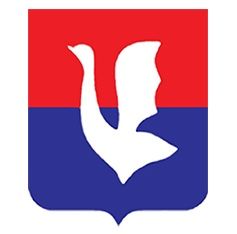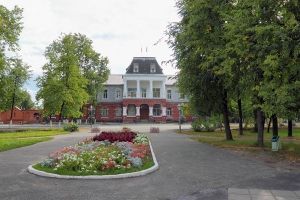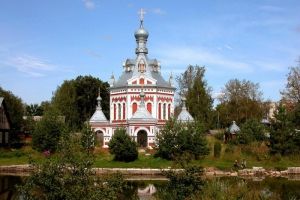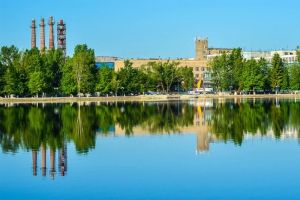Gus-Khrustalny

Gus-Khrustalny (until 1926 - Gus-Maltsovsky) is the administrative center of the Gus-Khrustalny district of the Vladimir region with a population of 55,973 people (2016). It is located in the forest area of Meshchera on the Gus River, 63 km south of Vladimir. The city of Gus-Khrustalny is the oldest center of the glass industry in Russia, which determines its unusual name.
History
However, the Meshcherskaya land was not the birthplace of Russian glassware. In 1723, by decree of Peter I, merchants S. Aksenov and N. Druzhinin were allowed to open a glass and crystal factory in Mozhaysk district, and in 1724 – to take in companions merchant Vasily Maltsov. After the death of his companions, in 1730 Vasily Maltsov became the sole owner of the crystal factory in the Mozhaisk district, and then transferred possession to his sons – Akim and Alexander. In the 1740s the Mozhaisk factory became famous all over Russia. In 1747, the Senate passed a decree banning the exploitation of glassworks and metallurgical plants in Moscow and the Moscow region in order to protect the forest from extermination. The Maltsov brothers decided to divide production. In 1750 Alexander moved his part of the crystal factory from Moscow to Orel province. Akim Maltsov in 1756 began construction of a new factory near the village of Nikulino in Vladimir province on the Gus River, taking more than 150 artisans from Mozhaisk. The place was chosen well: an abundance of raw materials (quartz sand, dolomite) and forests, the proximity of convenient waterways and trading centers – Moscow and Nizhny Novgorod.
This was the beginning of the city of Gus-Khrustalny. For more than a century and a half, crystal production on the Vladimir land belonged to the merchant-noble family of the Maltsovs. By the end of the 18th century, about one and a half dozen glassworks operated here. Progressive technologies were constantly introduced at the crystal factories and enriched the artistic image of crystal. In the 19th century, the Maltsov crystal factory already performed large orders of the imperial court, received the highest awards at the All-Russian and World exhibitions.
Together with the production, the village of Gus-Maltsovsky developed. In 1816, S.A. Maltsov built for the workers a stone temple of Joachim and Anna, which, already under I.S. Maltsov, was expanded in 1850 by the warm refectory Trinity Church. Progressive manufacturer, I.S. Maltsov built one of the first workers' settlements in Russia with good houses for two families (the total number of "Maltsov's houses" by the beginning of the 20th century was 427) and three-storied barracks for factory workers.
Initially, the settlement was located in the bend of the Gus River. The river was blocked by a dam, and an artificial lake was formed, still giving the Gus-Khrustalny an unusual flavor, that divided the village into two parts. The appearance of the older southern half was determined by the crystal factory, the spinning and weaving factories, the workers’ hospital, the pharmacy, the school for the craftsmen’s children, the factory shop – the trading rows for 20 offices with columns, galleries and balconies. On the southern outskirts of the village the chapel of St. Barbara of the 1880s preserved.
The center of the northern part of the village in the late 19th century became a church-architectural ensemble with the most beautiful St. George's Cathedral. It was built on funds of Yu.S. Nechaev-Maltsov by the famous architect L.N. Benois in the Old Russian style. The interior of the temple was decorated with paintings and mosaics of the famous artist V.M. Vasnetsov. Currently, the building of the St. George's Cathedral houses the Crystal Museum named after the Maltsovs. The architectural ensemble of the St. George's Cathedral was complemented by the stylistically close almshouse, built in 1897 according to the design of L.N. Benois, and two buildings of the men's primary school (the project of the architect V.A. Pokrovsky, Benois's assistant), one of which currently houses the Gus-Khrustalny Historical and Art Museum.
After the revolution in 1918 the Maltsov crystal factory was nationalized. In Soviet times, the products of the plant were presented at prestigious international exhibitions and received well-deserved awards.
In 1926, the village of Gus-Maltsovsky was renamed Gus-Khrustalny and became a working settlement, and since 1929 – the district center of the Vladimir county of the Ivanovo Industrial Region. In 1931 the working settlement of Gus-Khrustalny was transformed into a city. In 1944 Gus-Khrustalny passed into the newly formed Vladimir region.
Economy
The city of Gus-Khrustalny was awarded the Order of the Badge of Honor (1981) for success in the development of the domestic glass industry and contribution to the development of the national economy. The specialization of glass and crystal production was preserved and developed in the city not only in the Soviet, but also in the post-Soviet period, despite the serious economic difficulties of the 1990s. After a three-year period of suspension of production, at the end of 2014 the workshop of the Gus Crystal Plant, which produces color crystal, resumed its work. Today the factory is the leader in the Russian market for the production of highly artistic products from crystal. At the Gus Crystal Plant tours are organized, where visitors are told about the history of production, the craft of glass blowers, and also demonstrate glass manufacturing techniques and amazing exhibits - masterpieces of crystal creations.
Many of the city's production facilities have now been modernized in various areas of the glass industry: "Synthetic Crystals" is one of the world's largest manufacturers of artificial quartz crystals; Gus Glass Plant named after F.E. Dzerzhinsky is one of the leading manufacturers of technical glass in Russia; the Experienced Glass Plant has a large assortment of manufactured glassware; the plant "Red Echo" is engaged in the production and sale of glass containers, etc. Glass-making is also developing in the Gus-Khrustalny district: the "Symbol" plant is a multidisciplinary enterprise producing sheet, toned, instrument, automotive and other glass; the "RASCO" plant is the leading manufacturer of glass containers in Russia.
Famous people
Many famous people in Russia were born and worked in Gus-Khrustalny: S.S. Korsakov (1854-1900), an outstanding Russian psychiatrist; R.I. Soloukhin (1930-1988), an outstanding Soviet scientist in the field of mechanics and physics; V.V. Shilov (1964), People's Artist of the Russian Federation, portrait master, member of the Russian Academy of Arts; A.A. Reztsova (1964), two-time Olympic champion in biathlon, Olympic champion in cross-country skiing, the only woman in the world, who is Olympic champion at once in two kinds of winter sports, ets.
In August 1956 in the village of Miltsevo in Gus-Khrustalny district (now the village is part of the settlement Mezinovsky) the famous Russian writer A.I. Solzhenitsyn settled, after returning from the Kazakh exile to Russia. For about a year he taught mathematics and electrical engineering (physics) in the 8-10 classes of the Mezinov secondary school. The life of Solzhenitsyn in Miltsevo was reflected in the story "Matryonin Dvor". In 2013, in the village of Mezinovsky, the house where the writer lived was recreated, the Matryona’s yard. The Mezinovsky secondary school was given the name of A.I. Solzhenitsyn, a bust of the writer was opened near the school. Currently, the museum complex "Solzhenitsyn Routes" is being created here.
Natural objects
The city of Gus-Khrustalny is the organizing center of the Vladimir Meshchera – a special natural and cultural territorial complex located in the south-west of the Vladimir region.
 Tourism portal of the
Tourism portal of the






